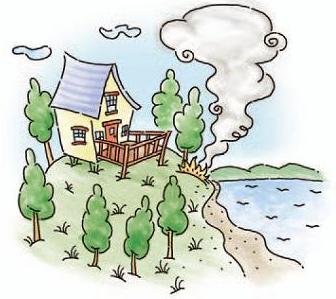Fire can spread rapidly through your home, leaving you as little as two minutes to escape safely once the alarm sounds. Your ability to get out depends on advance warning from smoke alarms and advance planning—a home fire escape plan that everyone in your family is familiar with and has practiced.
Before
.jpg) Install smoke alarms on every level of the home and outside each sleeping area. For the best protection, install interconnected smoke alarms in each bedroom and throughout the home. When one sounds, they all sound.
Install smoke alarms on every level of the home and outside each sleeping area. For the best protection, install interconnected smoke alarms in each bedroom and throughout the home. When one sounds, they all sound.
- Test alarms once a month. Change batteries at least once a year. Replace alarms every ten years.
- Consider installing smoke alarms with a "long-life" (10-year) battery. These alarms must be tested once a month.
- Consider installing a residential automatic fire sprinkler system.
- Plan and practice your family's escape route. Make sure your escape route is clear and available to use. Make sure all doors and windows open easily. Install ionization and photo-electric smoke alarms, make sure security bars on your doors and windows open easily from the inside. Remember to plan for your pets.
- Never use flammable liquids inside and store them in approved containers in well-ventilated areas. Safely discard all rags or materials that have been soaked in flammable liquids outside in a metal container.
- Inspect your chimney regularly. Clear any branches and debris from the chimney area. Make sure your chimney is at least three feet taller than the roof, insulated, and equipped with spark arresters on top.
- Keep space heaters at least three feet from combustibles and away from open flames.
- Keep matches and lighters up high, away from children's sight and reach.
- If you smoke, smoke outside. Use large deep, sturdy ashtrays.
- Stay in the kitchen when you are frying, grilling, or broiling food. If you leave the kitchen for even a short period of time, turn off the stove. If you are simmering, boiling, baking or roasting food, check it regularly, remain in the home while food is cooking, and use a timer to remind you that the stove or oven is on.
- Have an electrician check and maintain the wiring in your building. Inspect cords for frayed or exposed wiring and loose plugs. Do not run wires or cords under rugs, over nails, or across high-traffic areas. Do not overload extension cords. Make sure insulation does not touch bare electrical wiring.
- Inspect and clean dryer filters and exhaust frequently.
During
- Get out and stay out. Call the fire department from outside the home and do not return into the building until firefighters give the okay.
- If fire or smoke blocks your escape route, use your second way out. If you must pass through smoke, get low and go under the smoke and close doors behind you.
- If you need to open a closed door, feel the door. If it's hot, use your second way out.
- If smoke, heat, or flames prevent you from exiting a room, keep the door closed, call for help and wait by the window for rescue.
After
 Evacuate immediately if you detect heat or smoke in a fire-damaged building.
Evacuate immediately if you detect heat or smoke in a fire-damaged building.
- If you are a tenant, contact the landlord.
- If you have a safe or strongbox, wait several hours before opening it. It can hold intense heat and if you open it before it is completely cool, the contents could burst into flames.
Developed by NFPA. Funding provided by the U.S. Department of Homeland Security, Office of Domestic Preparedness.